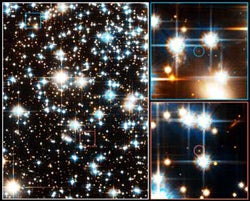In an announcement that sheds light on the origin and evolution of the universe, astronomers report the Hubble Space Telescope (HST) has imaged the faintest stars ever seen in a globular cluster.
Globular clusters, dense, spherical star formations containing hundreds of thousands of stars, are among the universe’s oldest objects.
These faint stars will act as clocks, explains Harvey Richer, leader of the research team that made the discovery. Determining the stars’ ages will allow astronomers to pinpoint exactly how and when globular clusters formed. “It’s a test of the age of the universe,” says Richer. “We’re learning about the timeline of the formation of nature.”
The team picked NGC 6397 because it’s the second closest globular cluster to the solar system at 8,500 light-years away. Moreover, judging by the lack of heavy elements in the stars’ atmospheres, NGC 6397 is one of the oldest globular clusters.
“The main scientific driver for this project was to use the surveyed white dwarfs as an age diagnostic,” explains Richer. White dwarfs are burned-out stellar corpses that have exhausted their nuclear fuel. As they age, white dwarfs cool in a predictable way, making them accurate timekeepers.
The team is still calculating NGC 6397’s age. “It’s not going to be far from 12 billion years,” assures Richer. Because the team refined the technique of using white dwarfs as time indicators, future attempts will produce more accurate results.
Hubble also surveyed NGC 6397’s population of red dwarfs, or very old, low-mass stars that can burn hydrogen in their cores. Theory predicts that the least massive red dwarfs are about 8 percent as massive as the Sun. Anything lower than that would become a brown dwarf, or failed star, and would slowly fade away to darkness.
The cut-off between red and brown dwarfs has never been experimentally observed — until now. Richer’s team found NGC 6397’s faintest red dwarfs are exactly as massive as theory predicts. “We think we’ve located the onset of the gap between main sequence stars and brown dwarfs,” says Richer.
The team’s findings appeared in the August 18, 2006, Science.










